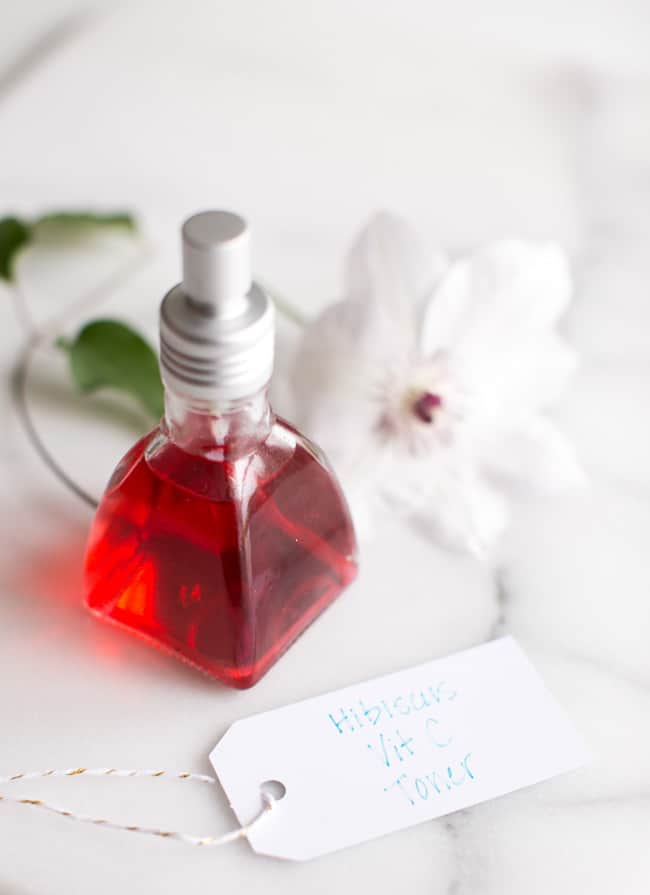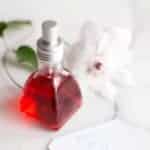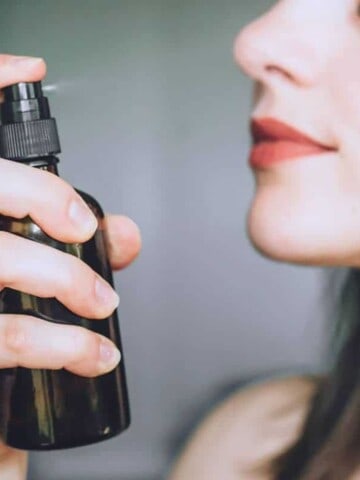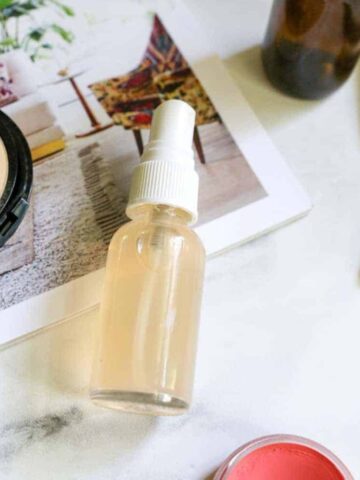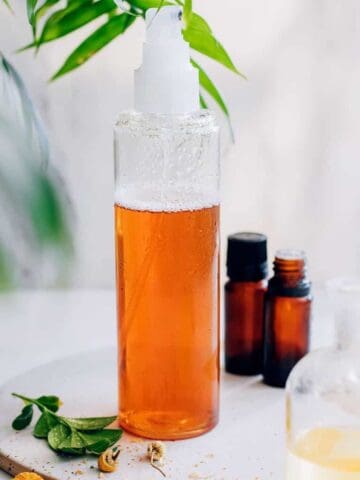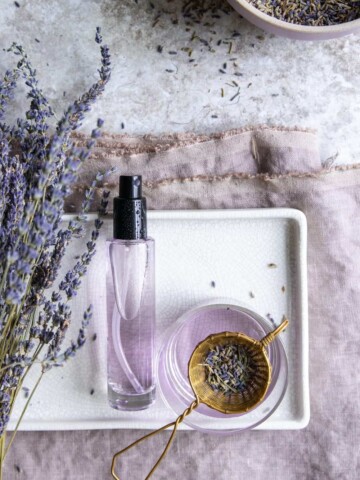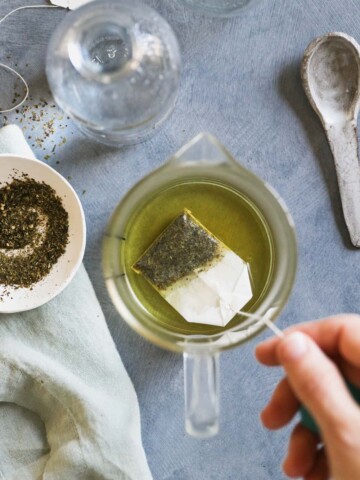Toner is so much easier—and fun—to use when it's applied as a face mist. Spritzing a vibrantly colored potion on your skin feels very spa-worthy, yes? Here's a simple vitamin C toner recipe that's easy to make, inexpensive, and highly effective at strengthening the skin's defenses against aging.
Jump to:
Why Use Toner?
Raise your hand if you've asked yourself this question. I know I have. It's usually after I run out of cotton balls and try to apply my toner with toilet paper. (A fine mess, my friends.)
Deborah, our Hello Glow esthetician, explained a while back that homemade toner is needed to balance the skin's pH after cleansing. It's also used to hydrate and refresh skin and deliver valuable nutrients.
But you don't need a fancy store-bought toner to reap the rewards. You can get many of the same benefits from ingredients lurking in your kitchen and medicine cabinet.
Ingredients
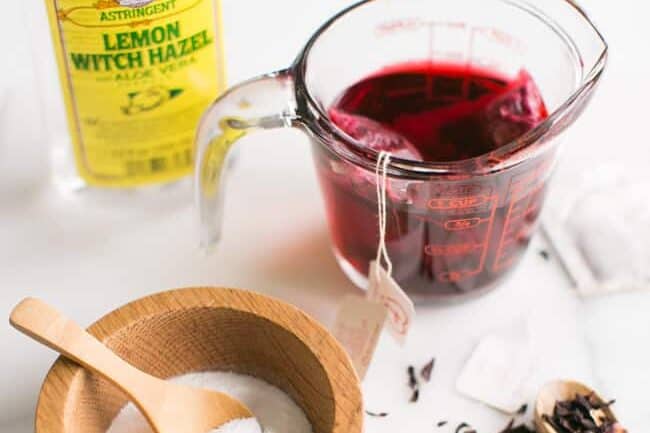
Our vitamin C toner recipe uses hibiscus and witch hazel to nourish skin and vitamin C to help fight the effects of aging. Here's what makes it work:
Hibiscus
Hibiscus is known for its ability to cleanse, tone, and balance the skin's delicate pH. The flower is rich in alpha-hydroxy acids that naturally exfoliate [source] and provide a tightening effect to the skin without stripping the natural (sebum) oils.
The tea also has a good supply of antioxidants [source], including a high vitamin C content [source], which fights the signs of aging.
Witch Hazel
Witch hazel is naturally anti-inflammatory and astringent [source], so it can tighten pores without over-drying like alcohol does. But most witch hazels you buy in the grocery store actually contain alcohol, so search out one (like Thayer's) that does not use alcohol in its preparation.
Vitamin C
Vitamin C is a bit of a wonder ingredient when it comes to aging skin. It fights free radical damage and combats the effects of aging as well as helping to balance the skin's pH levels [source].
Start with a small amount of vitamin C powder for two reasons: it breaks down quickly when added to liquid, losing its effectiveness, and it can cause irritation. Wellness Mama recommends no more than 1.5 teaspoons per batch of toner, so start small and work your way up.
Vitamin E
Add a small amount of vitamin E oil to stabilize vitamin C and enhance its antioxidant effects.
See recipe card for exact quantities.
Instructions
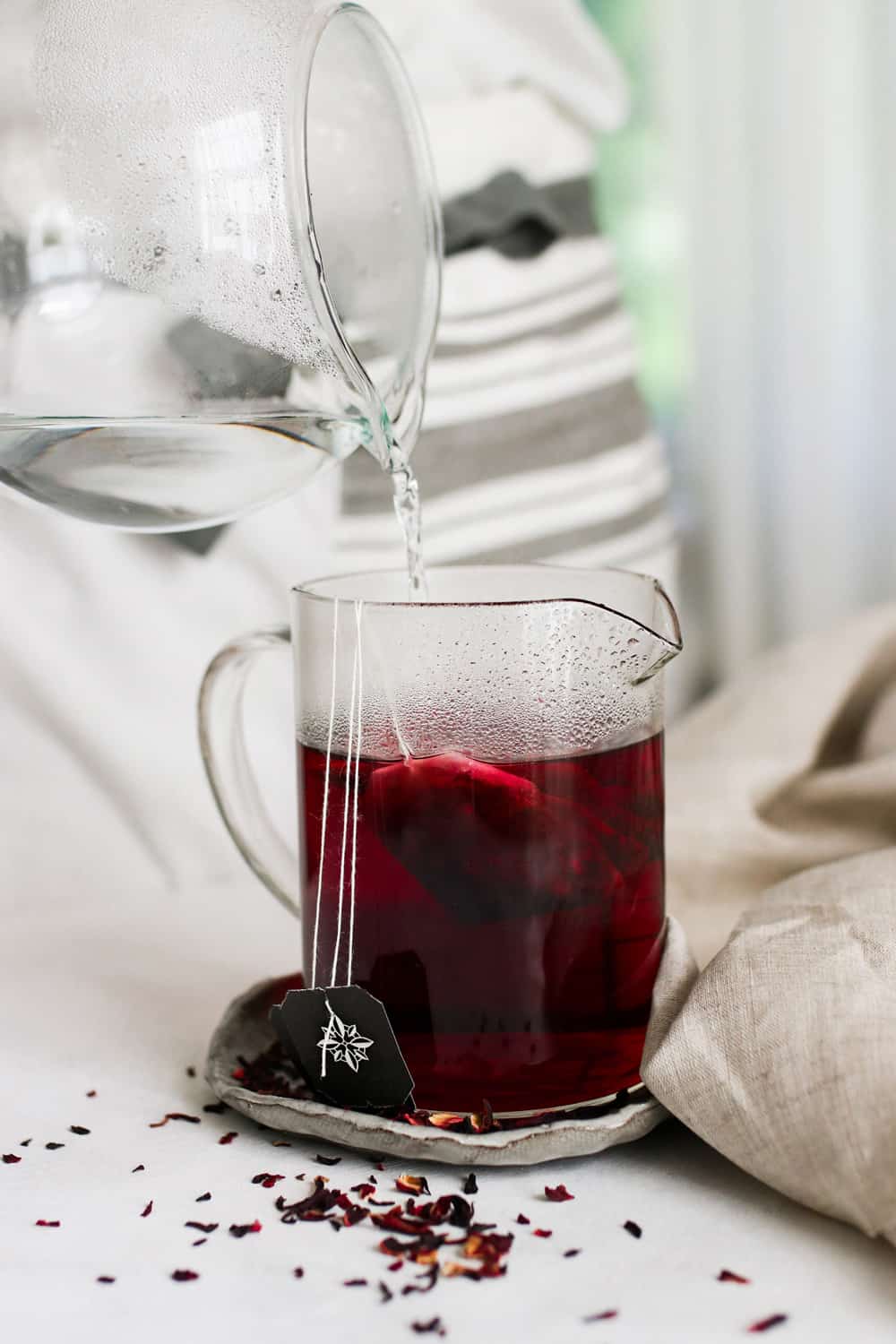
Step 1: Brew Hibiscus Tea
Bring water to a boil. Place tea bags in a heat-proof glass, and pour the hot water over the tea bags. Steep covered for 20 minutes.
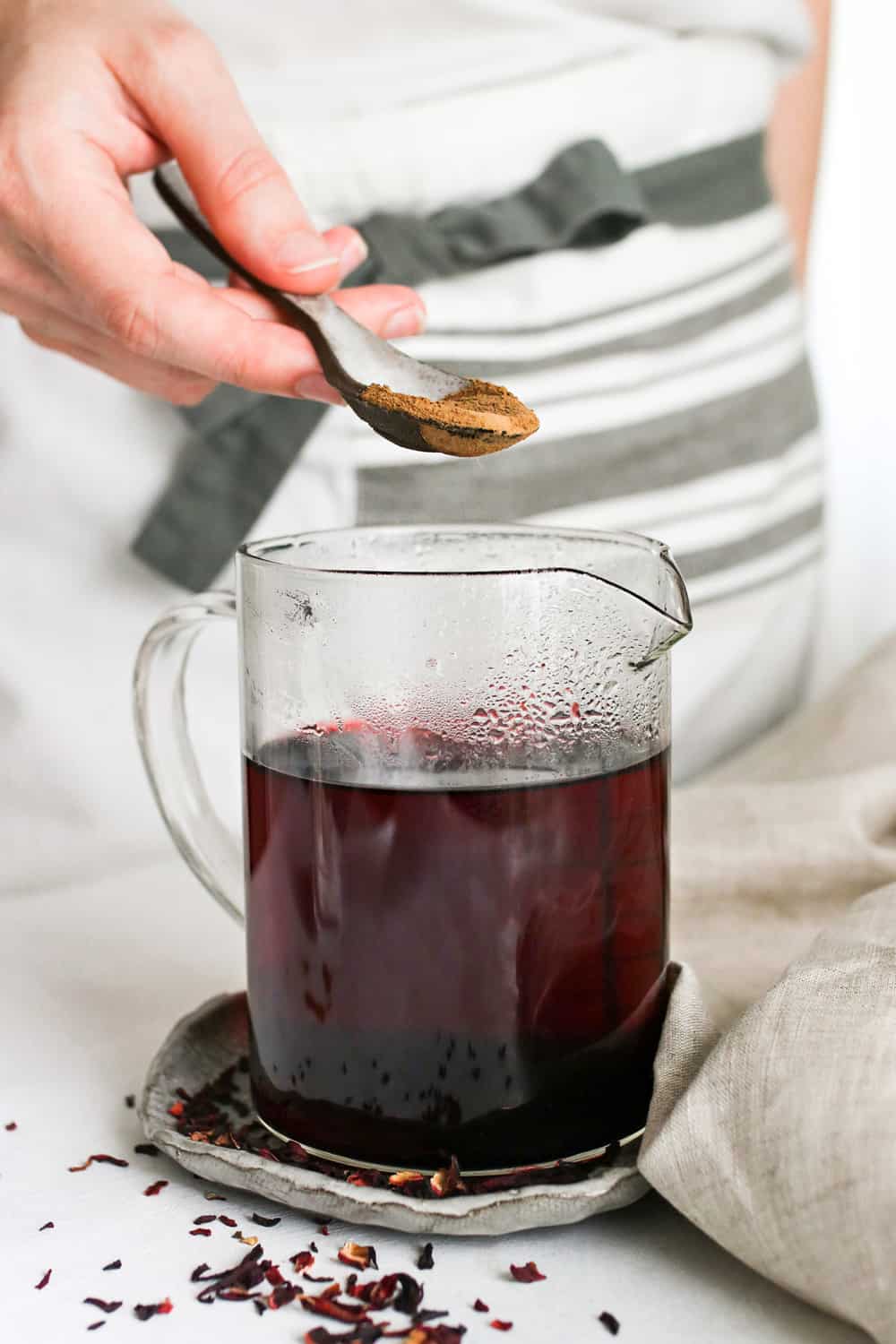
Step 2: Add Vitamin C
Remove tea bags and add alcohol-free witch hazel vitamin C powder, and vitamin E. Stir well to dissolve the vitamin C powder.
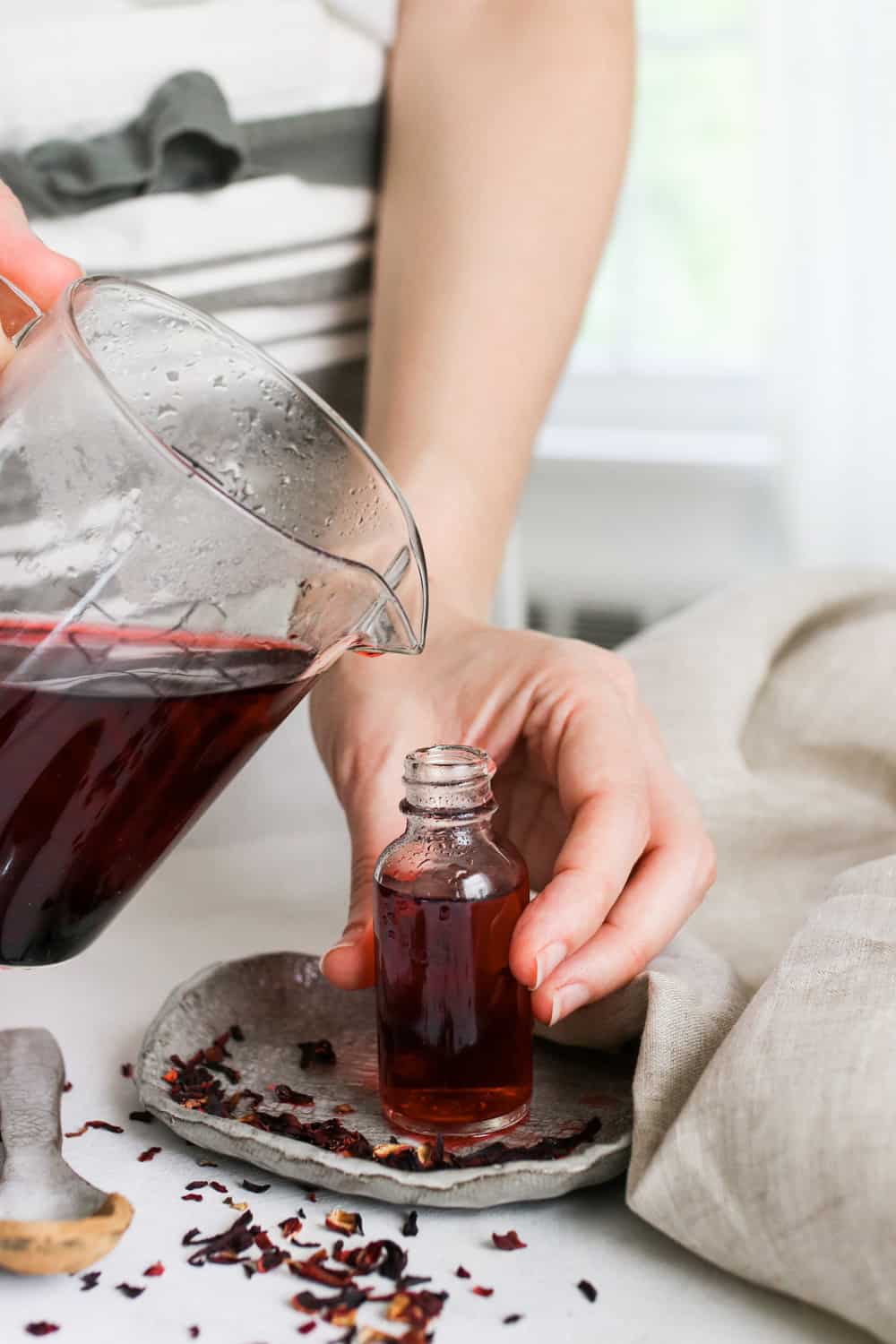
Step 3: Bottle Toner
Transfer to a small spray bottle. Keep in a cool, dry spot and use within 2 weeks. Refrigerate for longer shelf life.

Step 4: Patch Test
To use the first time, apply a bit to the neck and wait an hour or two to make sure you don’t have any sensitivity. Then use morning and night after washing your face.
Substitutions
Hibiscus tea — You ca also use rosehip tea or green tea.
Witch hazel — Rose water makes a great substitution for witch hazel. You can also leave the witch hazel out altogether and just use more tea.
Vitamin C powder — You can also use camu camu powder (though be warned it does not dissolve as well) or use a small amount of lemon juice.
Recipe Variations
1. Vitamin C and Rose Water Toner
Rosewater is a great cleanser and aids in removing oil and dirt accumulated in clogged pores. It acts as a natural toner due to its astringent properties. Aloe vera gel can help soothe skin irritation and even out skin tone.
Ingredients:
- ¼ teaspoon vitamin C powder
- ½ cup rose water
- 2 tablespoon aloe vera gel
Instructions:
- Mix the vitamin C powder with distilled water until completely dissolved.
- Add the aloe vera gel and mix thoroughly.
- Transfer the mixture to a dark-colored spray bottle or container.
- Keep refrigerated to maintain freshness.
2. Vitamin C and Green Tea Toner
Green tea toners are naturally anti-inflammatory and can protect the skin's protective barrier.
Ingredients:
- ¼ teaspoon vitamin C powder
- 1 /2 cup brewed green tea (cooled)
- 2-3 drops frankincense essential oil
Instructions:
- Dissolve the vitamin C powder in the cooled green tea.
- Add essential oil if desired, and mix well.
- Pour into a dark-colored container to protect it from light.
- Refrigerate to keep potent.
Recipes Without Vitamin C Powder
Creating a vitamin C-rich toner without using vitamin C powder is an excellent way to utilize natural sources of vitamin C.
3. Fruit Juice Toner
The natural acidity of citrus fruits can be sensitizing for some skin types, so it’s important to dilute them properly and avoid using them if you have very sensitive skin.
Ingredients:
- ½ cup freshly squeezed orange juice (or lemon juice for higher vitamin C content)
- ½ cup distilled water
- Optional: 1 tablespoon witch hazel (for additional astringent properties)
Instructions:
- Mix the freshly squeezed orange or lemon juice with distilled water. The water helps dilute the acidity to be gentler on the skin.
- If you’re using witch hazel, add it to the mixture for its skin-toning and soothing properties.
- Pour the mixture into a dark glass bottle to protect it from light.
- Store the toner in the refrigerator to preserve its freshness. Use within one week.
4. Rosehip Toner
Ingredients:
- ¼ cup rosehip tea (brewed strongly and cooled)
- ¼ cup distilled water
- Optional: a few drops of rosehip seed oil for added nourishment
Instructions:
- Brew a strong cup of rosehip tea and let it cool.
- Mix the cooled tea with distilled water.
- Add a few drops of rosehip seed oil if desired, for additional skin benefits.
- Transfer the mixture to a dark glass bottle for storage.
- Keep refrigerated and use within one week.
5. Citrus Peel Tea Toner
Peels from vitamin C-rich fruits like oranges, lemons, and other citrus fruits can be used to make an effective and natural antioxidant-rich citrus toner.
Ingredients:
- ½ cup cooled citrus peel tea
- ¼ cup witch hazel
- A few drops of essential oil for additional benefits (e.g., lavender for soothing, tea tree for acne-prone skin)
Instructions:
- Remove the peels from organic oranges, lemons, or grapefruits and cut them into smaller pieces. Try to remove as much of the white pith as possible to reduce bitterness.
- For a stronger tea, you can dry the peels first. Lay them out on a clean cloth or baking sheet and let them dry in a cool, dark place for a few days.
- Put the fresh or dried peels in a pot and cover them with water. Use about one tablespoon of dried peels or a handful of fresh peels for every cup of water. Bring the water to a boil, then reduce the heat and let it simmer for 10-15 minutes.
- In a bowl, combine the cooled citrus peel tea with witch hazel.
- If you’re using essential oils, add a few drops to the mixture.
- Pour the mixture into a clean, dark glass bottle to preserve the integrity of the vitamin C and any essential oils. A spray bottle is convenient for misting the toner directly onto your skin.
Storage
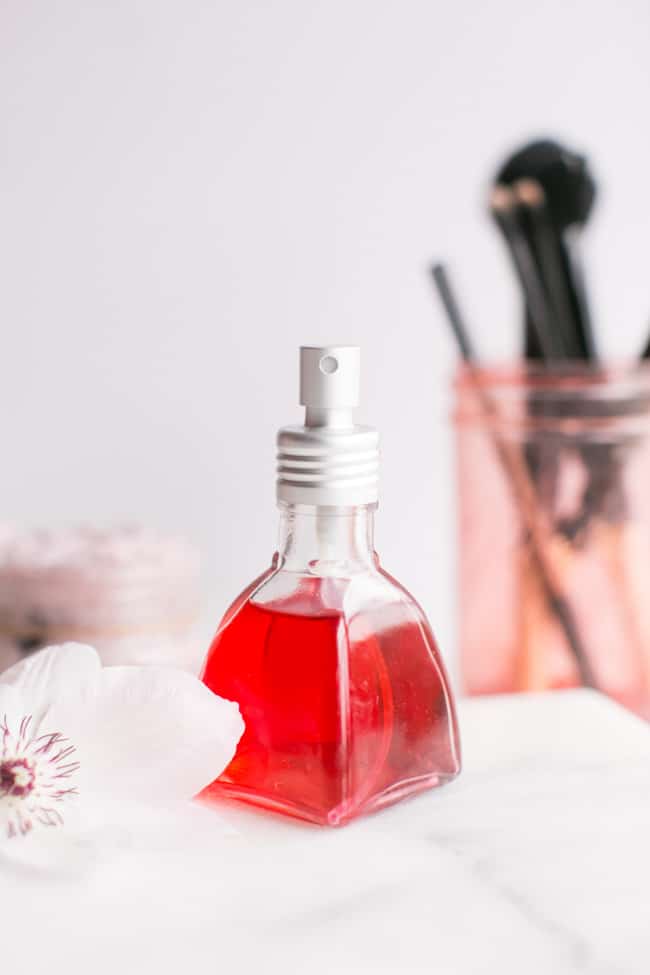
Vitamin C is sensitive to light and air, so storing it in a dark, airtight container in the fridge is crucial for maintaining its effectiveness. To slow the breakdown of vitamin C, use a dark-colored bottle to store the toner.
Since homemade formulations don't contain preservatives, it's best to make small batches and use them within 1-2 weeks. Freeze any leftover toner in an ice cube tray and thaw cubes one at a time whenever you run out of toner.
How to Apply Toner Effectively
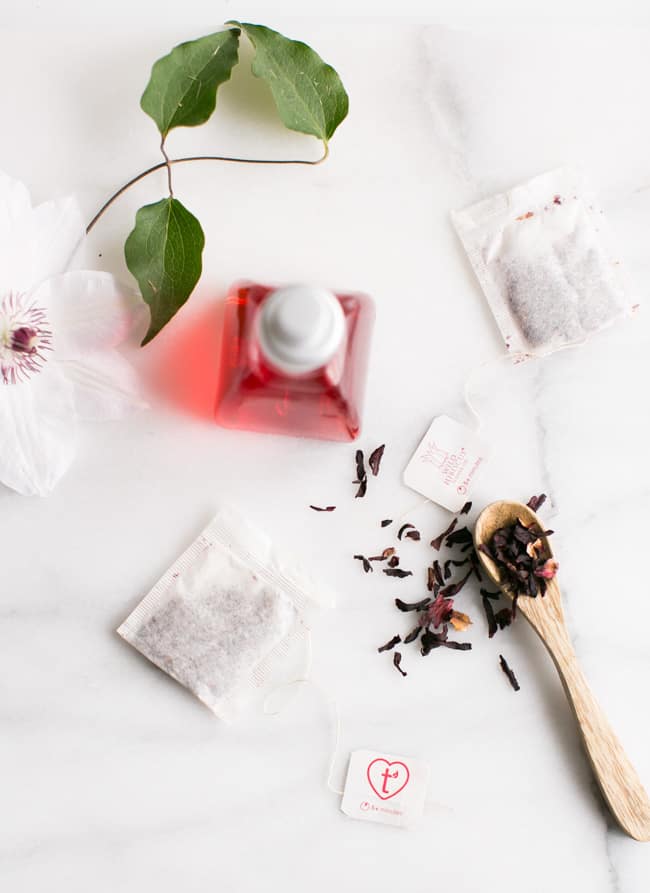
Since cotton balls are wasteful (both in regards to your wallet and the environment), I recommend storing your toner in a small spritzer bottle (in the fridge) and applying it directly to the skin. When it comes time to apply, it's best to:
Cleanse your skin. Either use a soap-based cleanser or an oil cleanser to remove dirt, grime, and makeup.
Spritz toner directly on skin. After washing your face but before applying serum or moisturizer, close your eyes, and lightly spritz your vitamin C toner all over your face.
Follow up with serums and moisturizer. Let the toner sink in for several minutes before applying the remaining products in your skincare routine.
Repeat morning and night. Use toner in the AM and PM, unless you start to notice dryness or irritation. If you do, cut back to using toner just once a day.
FAQ
I haven't had any issues with it staining my skin, but it may stain your clothes if you're not careful. Drape an old towel around your shoulders to prevent it from landing on your good clothes (or just don’t use it while wearing them). And feel free to use fewer tea bags (while keeping all other measurements the same) to lighten the color.
Sure, although I haven't tried it myself. I recommend using a broad-spectrum preservative that's made for water-based products, such as Leucidal Complete. Be forewarned; a preservative may change the consistency and effectiveness of the final product.
Not really. Combining a store-bought vitamin C serum with 6 ounces of tea will end up diluting the ratio of vitamin C, making it pretty ineffective. But by using vitamin C powder, you can increase or decrease the ratio to control the potency of your toner.
Sure! But there are a couple of important caveats:
1. Citrus essential oils increase photosensitivity (sensitivity to the sun), so use them sparingly, better in the evening, and always wear sunscreen!
2. When using EOs, it’s important to dilute them properly before applying directly to the skin. I would use 3–6 drops of a skin-friendly EO per ounce of toner.
3. Since oil and water don't really mix, make sure to give your toner a good shake before each use.
If you're not accustomed to using it, vitamin C may be too strong for your skin, which in turn may cause you to break out. (That's why we encourage you to start with ½ teaspoon and work up!)
If that happens, make another batch of toner with less vitamin C, and apply it once a day until your skin gets used to it. Then either increase the frequency or the amount of vitamin C in your toner until you get to the recommended ½ teaspoon.
Hibiscus Tea Toner Mist with Vitamin C
Equipment
- Tea kettle
- Heat-proof mug or cup
- Small spritzer bottle
Materials
- 6 ounces water
- 3 bags hibiscus tea
- 1 ounce witch hazel
- ½ teaspoon vitamin C powder
Instructions
- Bring 6 ounces of water to a boil. Place 3 tea bags in a heat-proof glass, and pour the hot water over the tea bags. Steep covered for 20 minutes.
- Remove teabags and add 1 ounce of alcohol-free witch hazel and ½ teaspoon of vitamin C powder. Stir well to dissolve the vitamin C powder.
- Transfer to a small spray bottle. Keep in a cool, dry spot and use within 2 weeks. Refrigerate for longer shelf life.
Notes
Related
Want to try more natural toner recipes to soothe and hydrate your skin? You might like these other options:
This article was medically reviewed by Dr. Gina Jansheski, a licensed, board-certified physician who has been practicing for more than 20 years. Learn more about Hello Glow's medical reviewers here. As always, this is not personal medical advice and we recommend that you talk with your doctor.
348

